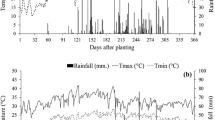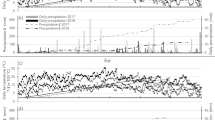Abstract
Canola—Brassica napus L.—is an economically major crop in many parts of the world. The seed yield of canola is often limited by poor plant establishment. This issue is serious in areas with short growing seasons, such as western Canada, where canola plants have a limited time span plasticity to adapt and compensate for yield losses due to poor or non-uniform plant establishment. The effect of spatial patterns of canola plant stands on seed yield is actually unknown. Therefore, we studied the impacts of uniformity of plant stands on pod formation, seed set, and crop yield of canola. Field experiments were conducted at 16 site-years across the different soil-climatic zones of the Canadian prairies. At each site-year, the cultivar InVigor® 5440, a glufosinate-resistant hybrid, was sown at 100, 80, 60, 40, and 20 plants per square meter with uniform and non-uniform stands. We found that spatially uniform stands increased seed yield by up to 32 % at low-yielding sites and by up to 20 % at the high-yielding sites compared to non-uniform plant stands. This effect is mainly due to increased number of fertile pods. The yield increase was more pronounced with plant densities lower than 60 plants per square meter. Also, canola seed yield depended largely on plant survival during the hot summer and was less affected by the rate of seedling emergence. We conclude that canola yield can be increased by improving the uniformity of plant spatial distribution patterns in the field regardless of environmental conditions.





Similar content being viewed by others
References
Ahmad E, Ghassemzadeh HR, Moghaddam M, Kim KU (2008) Development of a precision seed drill for oilseed rape. Turk J Agric For 32:451–458
Ahmadi SH, Ardekani JN (2006) The effect of water salinity on growth and physiological stages of eight canola (Brassica napus) cultivars. Irrigation Sci 25:11–20. doi:10.1007/s00271-006-0030-3
Aksouh-Harradj NM, Campbell LC, Mailer RJ (2006) Canola response to high and moderately high temperature stresses during seed maturation. Can J Plant Sci 86:967–980. doi:10.4141/P05-130
Al-Barrak KM (2006) Irrigation interval and nitrogen level effects on growth and yield of canola (Brassica napus L.). Sci J King Faisal Univ 7:87–103
Anastasi U, Santonoceto C, Monti M (2003) Growth and yield water status and use of spring and winter rapeseed in relation to time of sowing. Proceedings of the 11th International Rapeseed Congress 3:805–807
Angadi SV, Cutforth HW, McConkey BG, Gan Y (2003) Yield adjustment by canola grown at different plant populations under semiarid conditions. Crop Sci 43:1358–1366. doi:10.2135/cropsci2003.1358
Canola Concil of Canada (2012) Canola Performance Trials Results. http://www.canolacouncil.org/publication-resources/print-resources/crop-production-resources/grow-canola-resources/canola-performance-trials-results-2012/. Accessed 27 Sept 2013.
De Villiers RJ, Lamprecht SC, Agenbag GA (2006) Effect of chemical seed treatment on the germination and seedling growth of canola under different soil conditions. S Afr J Plant Soil 23:287–296. doi:10.1080/02571862.2006.10634767
Faraji A, Latifi N, Soltani A, Rad AHS (2008) Effect of high temperature stress and supplemental irrigation on flower and pod formation in two canola (Brassica napus L.) cultivars at Mediterranean climate. Asian J Plant Sci 7:343–351. doi:10.3923/ajps.2008.343.351
Gan Y, Angadi SV, Cutforth H, Potts D, Angadi VV, McDonald CL (2004) Canola and mustard response to short periods of temperature and water stress at different developmental stages. Can J Plant Sci 84:697–704. doi:10.4141/P03-109
Gan Y, Liang C, Huang G, Malhi SS, Brandt SA, Katepa-Mupondwa F (2012) Carbon footprint of canola and mustard is a function of the rate of N fertilizer. Int J Life Cycle Assess 17:58-68. doi:10.1007/s11367-011-0337-z
Ghassemi-Golezani K, Khomari S, Dalil B, Hosseinzadeh-Mahootchy A, Chadordooz-Jeddi A (2010) Effects of seed aging on field performance of winter oilseed rape. J Food Agric Environ 8:175–178
Ghassemi-Golezani K, Sheikhzadeh-Mosaddegh P, Shakiba MR, Mohammadi A, Nasrollahzadeh S (2012) Field performance of differentially matured seeds of oilseed rape cultivars. Res on Crop 13:128–133
Gill MS, Narang RS (1993) Yield analysis in Gobhi Sarson (Brassica napus L.) to plant density and nitrogen. Indian J Agron 38:257–265
Harker KN, O’Donovan JT, Blackshaw RE, Johnson EN, Lafond GP, May WE (2012) Seeding depth and seeding speed effects on no-till canola emergence, maturity, yield and seed quality. Can J Plant Sci 92:795–802. doi:10.4141/cjps2011-189
Hühn M (1999) Experimental results on the effects of nonregular spatial patterns of plants on yield per area. J Agron Crop Sci 182:89–97. doi:10.1046/j.1439-037X.1999.00262.x
Jasso de Rodríguez D, Angulo-Sánchez JL, Díaz-Solís H, Rodríguez-García R (2002) Rubber yield and guayule populations’ attributes in naturally reestablished wild stands in México. Ind Crop Prod 15:213–220. doi:10.1016/S0926-6690(01)00116-9
Johnson BL, Hanson BK (2003) Row-spacing interactions on spring canola performance in the Northern Great Plains. Agron J 95:703–708. doi:10.2134/agronj2003.7030
Kazemeini SA, Edalat M, Shekoofa A, Hamidi R (2010) Effects of nitrogen and plant density on rapeseed (Brassica napus L.) yield and yield components in Southern Iran. J Appl Sci 10:1461–1465. doi:10.3923/jas.2010.1461.1465
Kolb LN, Gallandt ER, Molloy T (2010) Improving weed management in organic spring barley: physical weed control vs. Interspecific competition. Weed Res 50:597–605. doi:10.1111/j.1365-3180.2010.00818.x
Kristensen L, Olsen J, Weiner J (2008) Crop density, sowing pattern, and nitrogen fertilization effects on weed suppression and yield in spring wheat. Weed Sci 56:97–102. doi:10.1614/WS-07-065.1
Kutcher HR, Warland JS, Brandt SA (2010) Temperature and precipitation effects on canola yields in Saskatchewan, Canada. Agr Forest Meteorol 150:161–165. doi:10.1016/j.agrformet.2009.09.011
Larsen SU, Povlsen FV, Eriksen EN, Pedersen HC (1998) The influence of seed vigour on field performance and the evaluation of the applicability of the controlled deterioration vigour test in oil seed rape (Brassica napus) and pea (Pisum sativum). Seed Sci Technol 26:627–641
Larson EJ, Vanderlip RL (1994) Grain sorghum yield response to nonuniform stand reductions. Agron J 86:475–477. doi:10.2134/agronj1994.00021962008600030003x
Leach JE, Stevenson HJ, Rainbow AJ, Mullen LA (1999) Effects of high plant populations on the growth and yield of winter oilseed rape (Brassica napus). J Agr Sci 132:173–180. doi:10.1017/S0021859698006091
Legendre P, Fortin M (1989) Spatial pattern and ecological analysis. Vegetatio 80:107–138. doi:10.1007/bf00048036
Liu C, Gan Y, Poppy L (2014) Evaluation of on-farm crop management decisions on canola productivity. Can J Plant Sci 94:131-139. doi:10.4141/cjps2013-121
McGregor DI (1981) Pattern of flower and pod development in rapeseed. Can J Plant Sci 61:275–282. doi:10.4141/cjps81-040
Naghizadeh M, Hasanzadeh R (2012) Effect of plant density on yield, yield components, oil and protein of canola cultivars in Hajiabad. Adv Environ Biol 6:1000–1005
Olsen J, Kristensen L, Weiner J, Griepentrog HW (2005) Increased density and spatial uniformity increase weed suppression by spring wheat. Weed Res 45:316–321. doi:10.1111/j.1365-3180.2005.00456.x
Perry JN, Liebhold AM, Rosenberg MS, Dungan J, Miriti M, Jakomulska A, Citron-Pousty S (2002) Illustrations and guidelines for selecting statistical methods for quantifying spatial pattern in ecological data. Ecography 25:578–600. doi:10.1034/j.1600-0587.2002.250507.x
Pronk TE, Schieving F, Anten NPR, Werger MJA (2007) Plants that differ in height investment can coexist if they are distributing non-uniformly within an area. Ecol Complex 4:182–191. doi:10.1016/j.ecocom.2007.06.007
Qaderi MM, Kurepin LV, Reid DM (2012) Effects of temperature and watering regime on growth, gas exchange and abscisic acid content of canola (Brassica napus) seedlings. Environ Exp Bot 75:107–113. doi:10.1016/j.envexpbot.2011.09.003
Qaderi MM, Reid DM (2009) Crop responses to elevated carbon dioxide and temperature. In: Climate change and crops. Springer, Berlin, pp 1–19
Sierts HP, Geisler G, Léon J, Diepenbrock W (1987) Stability of yield components from winter oil-seed rape (Brassica napus L.). J Agron Crop Sci 158:107–113. doi:10.1111/j.1439-037x.1987.tb01153.x
Tesfamariam EH, Annandale JG, Steyn JM (2010) Water stress effects on winter canola growth and yield. Agron J 102:658–666. doi:10.2134/agronj2008.0043
Tokatlidis IS, Koutroubas SD (2004) A review of maize hybrids’ dependence on high plant populations and its implications for crop yield stability. Field Crop Res 88:103–114. doi:10.1016/j.fcr.2003.11.013
Uriarte M, Canham CD, Thompson J, Zimmerman JK (2004) A neighborhood analysis of tree growth and survival in a hurricane-driven tropical forest. Ecol Monogr 74:591–614. doi:10.1890/03-4031
Velička R, Marcinkevičiene A, Kosteckas R, Pupaliene R, Duchovskis P, Brazaityte A (2012) The influence of crop density on the photosynthetic characteristics and productivity of the spring oilseed rape under non-fertilized and fertilized conditions. J Food Agric Environ 10:850–856
Wilson DS, Tilman D (1991) Components of plant competition along an experimental gradient of nitrogen availability. Ecology 72:1050–1065
Acknowledgments
This research was supported by the Canadian Agri-Science Clusters Initiative of the Growing Canadian Agri-Innovations of Agriculture and Agri-Food Canada, Canola Council of Canada, and Saskatchewan Canola Development Commission. We thank Lee Poppy at Swift Current, Colleen Kirkham and Dan Cross at Melfort, Larry Michielsen, Patty Reid, Elizabeth Sroka and Jeenifer Zuidhof at Lacombe, Derek Lewis at Winnipeg, Mark Sandercock at Morden, and Randy Shiplack at Indian Head for their technical assistance and contributions to this work.
Author information
Authors and Affiliations
Corresponding author
About this article
Cite this article
Yang, C., Gan, Y., Harker, K.N. et al. Up to 32 % yield increase with optimized spatial patterns of canola plant establishment in western Canada. Agron. Sustain. Dev. 34, 793–801 (2014). https://doi.org/10.1007/s13593-014-0218-5
Accepted:
Published:
Issue Date:
DOI: https://doi.org/10.1007/s13593-014-0218-5




